History
Evidence dates the island’s first settlers, probably Ciboney Indians (a subgroup of Arawaks), back more than 3000 years. Around 800 A.D another subgroup of Arawaks migrated from South America. Both were farming and fishing societies, living in villages of straw-roofed buildings that apparently withstood hurricanes–or were easily rebuilt. Their pastoral society valued artistic creativity and spiritual rites. 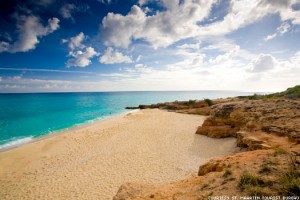 Their lives were eventually destroyed centuries later with the intrusion of the alien and hostile Carib Indians who gradually killed off the Arawak men and enslaved the women.
Their lives were eventually destroyed centuries later with the intrusion of the alien and hostile Carib Indians who gradually killed off the Arawak men and enslaved the women.
By the time Europeans began to explore the Caribbean, in the 15th century, Carib society had almost completely displaced the Arawaks and the island was nearly homogenous. Post-Columbus explorers, unbeknownst at first to the natives, claimed the island for European powers after decimating the Arawak culture. Spain (for a while), then France and Holland established settlements and trading enterprises which controlled the island then and now.
Until 2010 the Dutch half of the island was part of an entity called Netherlands Antilles. But that was dissolved and each of the six Antilles territories now has a separate name: Curacao, Aruba, Bonaire in the south near Venezuela; the other three are St Maartin, Saba and St Eustatius (Statia) in the north (562 miles away) near the Virgin Islands. All are under Dutch sovereignty.
This pretty island also has its recent shady side. The Dutch Ministry of Justice investigated organized crime in Sint Maarten (2004-05) and concluded that money laundering and cocaine transfers were widespread. It also alleged that money from 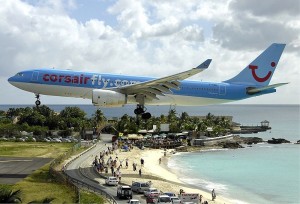 the island was used to finance terrorist networks such as Hamas and its associate the Holy Land Foundation, as well as the Taliban. However, only one authority figure was jailed. Others involved no doubt escaped to other islands.
the island was used to finance terrorist networks such as Hamas and its associate the Holy Land Foundation, as well as the Taliban. However, only one authority figure was jailed. Others involved no doubt escaped to other islands.
The population as of 2010 was about 37,500. There are two universities, one is the American University of the Caribbean School of Medicine (previously on Montserrat) in Cupecoy (near the nude beach). The other is the University of St. Martin in Philipsburg, the capital, which has fewer than 2000 local resident (and doubles in the high tourist season).
Present Day Experience: Tourist Gays
Homophobia exists in every country in the world today, even in a ‘neutral’ place such as St Martin2 where homosexuality appears to have a tolerated existence. And, like cancer, homophobia shows up variously among different groups. In this case, one population consists of gay tourists who come and go for a week and the other are the gay locals who live daily, weekly yearly with the attitudes and circumstances of their families and peers.
The tourists have it easy. Their visit starts with a comfortable fly-in or cruise-in, then sleeping in pampered quarters, eating gourmet meals, finding a lounge on a sunny beach (nude or not), driving around the forested hills and scuba diving to see pretty fish. For these folks the gay scene is mostly ‘gaydar’ on the street, visual Speedo treats on a beach (with maybe a ‘quickie’ in a beachside cave), gay friendly 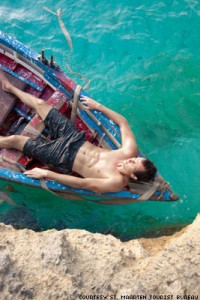 bars and restaurants and , likely, a party with new or old friends at the gay-owned Echo Bar at sunset.
bars and restaurants and , likely, a party with new or old friends at the gay-owned Echo Bar at sunset.
The tolerance level for LGBT visitors is higher than for local LGBTs, especially in the commercial milieu. The motive is more economic than social; most gay people who are ‘visible’ in St Maartin are tourists whose pink dollars buy goods and services that support the tourist industry and employ thousands of workers.
As a result, the homophobia visitors encounter is subtle and cultural. No public displays of affection (PDA), an occasional frown from a waiter, an anti-gay rant in the newspaper, a very rare verbal or physical attack (one in 2004), opposition to gay marriage in the media, the unnoticed absence of any LGBT rights or advocacy group and of course the unseen, unheard and un-enforced law that criminalizes homosexuality.
None of his is very obvious. The merchants are pleased with the dollars and the tourists are pleased with their tans lines and straw hats. It’s not so bad, most say. “St Martin2 was tolerant for LGBTs, we had no feelings of discrimination, people were friendly and helpful…” In turn, thousands of LGBT tourists return home and spread positive word-of-mouth gossip worldwide about the pretty island’s virtues while some American and European gays are hooked and establish a primary or secondary residence.
Present Day Experience: Local Gays
For the local LGBT folks things are not so breezy–well, they are and they are not. If a man or woman prefers total discretion they can live tolerably well, even if single, working hard and being cordial–although that may be suspect and people will ‘talk’ but without much pressure to get married. Others, more discrete, will mask their same-sex impulses behind marriage and kids. This is the most common and safest ‘cover’ for closeted gays around the world. Still, others who don’t want to hide and yet don’t want to wave flags and rainbows are likely to see disapproval from public institutions (schools, churches, media, politicians) and in private situations (family, neighbors); not from all and not all the time. Such attitudes when expressed directly are intended to humiliate or embarrass yet are not overt enough to be called discrimination. It is an frustrating gay area.
For hundreds of years, from the 15th century, the Dutch, French and English sailed around the world setting up colonies and commercial enterprises. As they conquered and controlled they imposed their laws on the native inhabitants and new settlers, which included 16th century anti-buggery laws. Eventually, the French decriminalized it in 1791, the Dutch in 1811 and the English not until 1967. As a result, today homosexuality is legal in both French Saint Martin and Dutch Sint Maartin.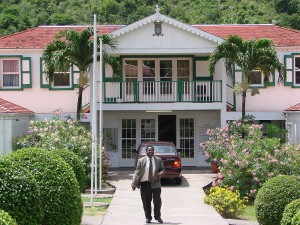
As well, anti-discrimination statutes were enacted so there are legal protections against offensive discrimination, if it can be proven which is not always easy. That is to say, although discrimination is illegal LGBT people are still subject to being harassed, fired from a job (for alleged other reasons), scandalized and otherwise be victimized by anyone with a bias against gays.
The most obvious contribution to homophobia in Sint Maartin comes from religious organizations, from the pastors in their pulpits and sermons. The dominant Roman Catholic church on the island is no friend to the gay world. The quantity and quality of their bigoted messages are one of the primary fuels for the fire of discrimination, for which they offer no apology. Such as this anti-gay rant.
A third contributor to St Maartin’s subtle homophobia is the absence of a human rights organization with a mission to advance the cause of equality and push back against prejudice and injustice.
Fourth, the lack of educational curricula in schools about tolerance and human rights. The Dutch government has for the past recent years urged ‘sexual diversity classes’ (in Bonaire, St. Eustatius and Saba) but St Maartin has resisted because it is “considered a sensitive topic.”
The result of such negativity and discrimination toward same-sex desire is that many closeted people (mostly married men) go underground and have sex on the ‘down-low’. Such secretive behavior makes them virtually impossible to identify and alienates participants from being understood and supported in their guilt and fear. Most often they do not identify with being gay and do not want to ‘come out’. Being an MSM (a man who has sex with men) is an anxiety-ridden secret that separates them from both gay and straight life. It also distances them from getting health education and care for STDs and HIV. There is an HIV educational organization in St Maartin.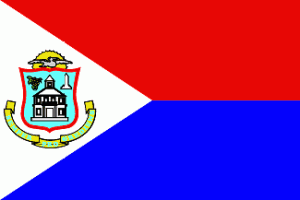
Hence the difference between local gay men and tourist gay men in St Maartin, and few if any (more like none) of the ‘liberated’ tourists understand these local issues and offer to hang around long enough to mount a protest or lobbying strategy to change the attitudes of this otherwise happy-gay-holiday destination.
The Gay Scene and Sint Maartin: Advice
Adding to the seeming inequality of these two populations of gay people, it is obvious that the gay tourists dominate the overall local scene in numbers, ‘out’ behaviors (more overt and confident), spending for services and goods and with party making in private or in clubs. Here are some posted commentaries:
“The gay and lesbian scene on the island is not that noticeable, although St. Maarten/St. Martin overall is gay-friendly and popular with the LGBT crowd. The best way to meet fellow queers is at Cupecoy Beach, close to the Dutch-French border on the western side of the island. It’s a string of three, white-sand beaches set against a backdrop of caves, beautiful rock formations and cliffs. Gays can also be found on the beaches of Baie Rouge and Orient Beach, both also nude. Beyond the beach and shopping scene, the island has great deep-sea fishing, and scuba diving is excellent, with various reef, wreck, night, cave and drift diving options.”
“The southern, Dutch part of the island tends to be bustling with shopping cruise ship passengers, while the cafe-filled northern French part is a bit sleepier. Overall, the island is very sophisticated and built-up. St. Maarten/St. Martin is a shopper’s paradise, with duty-free malls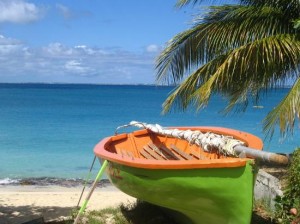 everywhere and no local sales tax. Prices are sometimes lower here than anywhere else in the Caribbean and fine liqueurs, cigarettes, French perfumes can be up to half off their American prices.”
everywhere and no local sales tax. Prices are sometimes lower here than anywhere else in the Caribbean and fine liqueurs, cigarettes, French perfumes can be up to half off their American prices.”
“The Dutch side has bigger and more lavish hotels, more built up, more night life Casinos. More traffic. but can feel removed from the locals. The French side is said to have more than 300 restaurants and the best dining in the Caribbean, although is farther from the best shopping. French side: More laid back, less congested. Avoid deserted beaches. Empty and quiet beaches may seem like paradise, but they can make you a target for theft. On the flip side, when you’re on a crowded beach (especially a nude one), don’t leave any of your belongings or clothing unguarded on the sand. Link here.
“St. Martin is considered as most gay friendly travel destination in the Caribbean after Curaçao and Puerto Rico. Even though you can’t expect a distinctive gay scene with only 85.000 inhabitants, there are however some cafes, bars and restaurants in Marigot, Philipsburg and other places which are popular with gays. The one and only gay location with a long tradition is [Club Eros] in Marigot, where gay parties take place every Saturday.
“Among the many beaches there are three gay favorites to relax, meet and cruise: Cupecoy Beach in the southwest (Dutch part), Baie Rouge in the west (French part) and Baie Oriental in the island’s northeast. 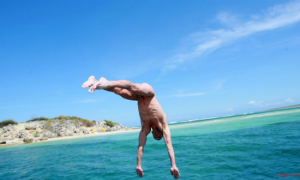 All three beaches are clothing optional. Updated information & tips are available on the website of the only gay guesthouse [Villa Rainbow] (Pic Paradis) or personally from locals at Club Eros.
All three beaches are clothing optional. Updated information & tips are available on the website of the only gay guesthouse [Villa Rainbow] (Pic Paradis) or personally from locals at Club Eros.
Apart from the mentioned Villa Rainbow gay travelers have a good range of gay friendly hotels and guesthouses.” Link here.
Also see:
Comparison of the two halves
St Maartin AIDS Foundation
Homophobia in the Caribbean
Trip Advisor
















